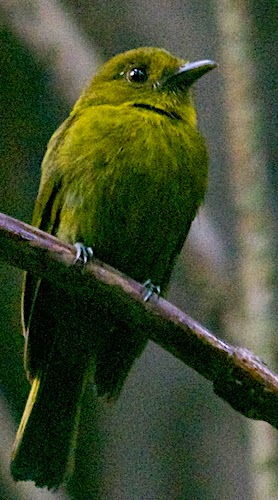Sapayoidae -Sapayoa

The sapayoa (sometimes the broad-billed sapayoa) Sapayoa aenigma is a suboscine passerine found in lowland rainforests in Panama and north-western South America. As the epithet aenigma (the enigma) implies, its relationships have long been elusive. It is easy to overlook, but appears to be common in a wide range and is not considered threatened by the IUCN. It has always been considered a monotypoic genus but has more recently been given the status of being its own monotypic family, spit from the Broadbills. Recent research shows it is probably and old world suboscine passerine.
It is a small, olive-colored bird, somewhat paler below and with a yellowish throat. Its habitus resembles a bigger, longer-tailed, broader-billed female manakin. It is rare to uncommon in the forest understory, favoring ravines and small streams. It is usually seen in pairs or mixed-species flocks. It spends long periods perching, then sallies up to pick fruit or catch insects, on foliage or in mid air, with its flat, wide bill in a way reminiscent of flatbills.
They build a nest suspended from a branch usually above a stream. It is a pear shaped structure with the larger end at the top and fibres hanging beneath. The entrance is at the side.
Sapayoa (Broad-billed Sapayoa) Sapayoa aenigma
-
Wikipedia
Webpage
-
Number of bird species: 1
